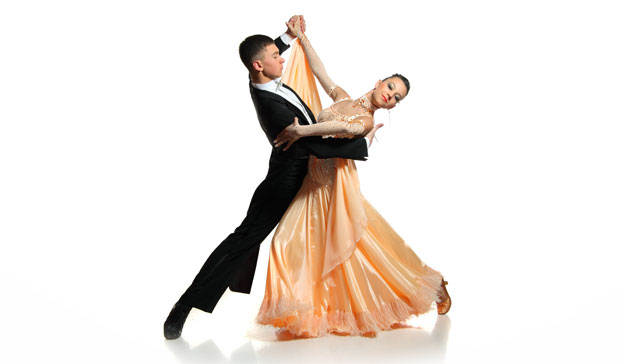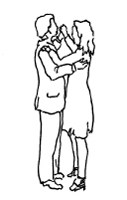Waltz
From Londonhua WIKI
Waltz
 | |
| Stylized Waltz Frame |
|---|
Overview
Waltz is a modern Ballroom Dance, first appearing in England in the early 19th century [1]. Waltz has appeared widely in films and the popular media, and is often the form of dance most closely associated with the Ballroom category.
Contents
Background
Waltz is the oldest modern Ballroom Dance [2], having been introduced to the English ballroom on 1812 [3]. The name of the dance comes from the German "waltzen," meaning "to revolve[4]." This name comes from the primary form of the dance, in which couples are constantly turning and revolving as they make their way around the line of dance[5]. The waltz is danced in 3/4 time[6].
Technique
Many varieties of waltz exist, as detailed in the Varieties section. The most common variety, though, is known as International Waltz or Standard Waltz. In its most basic form, Standard Waltz is characterized by closed hold frame and the Closed Change step patterns. Throughout all of its figures and steps, Standard Waltz is recognizable by its rise-and-fall movement.
Closed Hold
In closed frame for Standard Waltz, and in most other varieties of waltz, the leader places his right hand on the follower's left shoulder blade, with the side of his thenar and wrist crease against the back of her armpit. The follower places her left hand on the leader's upper arm, near the shoulder. The leader's left arm is raised to slightly lower lower than shoulder-height, and the elbow is bent sharply to extend the hand upward. The follower reflects this position with her right arm, wrapping her fingers around the leader's hand between the thumb and fingers. The couple then spreads their elbows wide to the side, maintaining light body contact with the follower slightly to the right of the leader.The leader and follower both look over their respective left shoulders [7].
Closed Changes
The Closed Changes, known separately as the Left Closed Change and the Right Closed Change, are the most fundamental steps of Standard Waltz, and of most other forms of waltz, as well.
Left Closed Change
For Leaders: At the beginning of this step, the leader's body weight is entirely on his right foot. First, he steps forward with his left foot on the count of one, steps diagonally forward with his right foot on the count of two, and finally closes his feet and changes his weight to his left foot on the count of three.
For Followers: Like the leader, the follower begins this step with her weight on her left foot. She steps backwards with her right foot on the count of one, steps diagonally backwards with her left foot on the count of two, and closes her feet and changes her weight to her right foot on the count of three.
Right Closed Change
For Leaders: For this step, the leader begins with his weight on his left foot. He then steps forward with this right foot on the count of one, steps diagonally forward with his left toof on the count of two, and finishes by closing his feet and changing his weight to his right foot on the count of three.
For Followers: The follower begins with her weight on her right foot, then steps backwards with her left foot on the count of one, steps diagonally backwards with her right foot on the count of two, and closes her feet and changes her weight to her left foot on the count of three.
History
Up until the introduction of Waltz into the English ballroom scene in 1812, social dancing in England had largely been dominated by forms of contra dancing[8]. These styles were typified by minimal body contact and the regular changing of partners[9]. This form of social dancing had been the main feature of English ballrooms for hundreds of years, so waltz, with its close frame, body contact, and constant turning came as a shock[10].
Waltz's entrance into England is traced to a single dance club in London. Almack's Assembly Rooms, located in the heart of St. James's on King Street, was an elite ballroom that reached a peak during the Regency. Here, members of London's fashionable elite would gather for Wednesday evening balls, often as a way to search for matchmaking opportunities[11]. In fact, Almack's was "notorious" as a "marriage market" for debutantes[12]. When waltz was introduced into this charged social scene, it instantly became both popular and notorious[13]. Because the hold for waltz was so close and sustained, it was interpreted as highly lascivious. Lord Byron was among the early skeptics, having seen the waltz performed soon after its introduction. He anonymously published a poem to express his thoughts, appearing in 1813 and titled, "Waltz: An Apostrophic Hymn[14]." The following is an excerpt.
Waltz—Waltz—alone both legs and arms demands,
Liberal of feet—and lavish of her hands;
Hands which may freely range in public sight,
Where ne’er before—but—pray ‘put out the light.’
Methinks the glare of yonder chandelier
Shines much too far—or I am much too near;
And true, though strange—Waltz whispers this remark;
'My slippery steps are safest in the dark!' [15]
In fairness, this opinion may not have been entirely unfounded. There are reports that couples, while waltzing through the darker corners of ballrooms, there were sometimes "bolder embraces and kisses[16]."
Varieties of Waltz
Over time, waltz has evolved into many differentiated styles. These styles include:
- American/Smooth Waltz - This style is characterized by an optional open frame, allowing dancers to complete complex patterns with only one hand or no hands touching [17].
- International/Standard Waltz - This style is known for its closed hold and highly standardized movements. This form of waltz is the most common form of waltz danced in Ballroom competitions around the world[18].
- Viennese Waltz - Unlike for other forms of waltz, the tempo for Viennese Waltz is nearly two hundred beats per minute. This is much faster than seen in other forms. Closed hold is less strict in Viennese Waltz than in Standard Waltz, allowing dancers to underarm turns and other other figures in open hold. Because of its rapid pace, Viennese Waltz has less rise and fall and less sway than other forms of Waltz[19].
- Country Western Waltz - This style is danced at a tempo slightly slower than Viennese Waltz and includes many of the open hold characteristics of American Waltz. However, Country Western Waltz makes greater use of shadow position and running progressive steps than other styles[20].
References
- ↑ T. (n.d.). Waltz: Dance. Retrieved May 10, 2017, from https://www.britannica.com/art/waltz
- ↑ Waltz. (n.d.). Retrieved May 10, 2017, from https://www.americandancesportcenter.com/waltz
- ↑ Wilson, C. A. (n.d.). The Arrival of the Waltz in England, 1812. BRANCH. Retrieved May 9, 2017, from http://www.branchcollective.org/?ps_articles=cheryl-a-wilson-the-arrival-of-the-waltz-in-england-1812
- ↑ T. (n.d.). Waltz: Dance. Retrieved May 10, 2017, from https://www.britannica.com/art/waltz
- ↑ Waltz. (n.d.). Retrieved May 10, 2017, from https://www.americandancesportcenter.com/waltz
- ↑ Waltz. (n.d.). Retrieved May 10, 2017, from https://www.americandancesportcenter.com/waltz
- ↑ Ballroom Dance Holds. (n.d.). Retrieved May 10, 2017, from http://waltz-dance.com/ballroom-dance-holds.html
- ↑ Wilson, C. A. (n.d.). The Arrival of the Waltz in England, 1812. BRANCH. Retrieved May 9, 2017, from http://www.branchcollective.org/?ps_articles=cheryl-a-wilson-the-arrival-of-the-waltz-in-england-1812
- ↑ Contra Dance - History of Contra Dancing. (n.d.). Retrieved May 10, 2017, from http://www.dancefacts.net/dance-list/contra-dance/
- ↑ Wilson, C. A. (n.d.). The Arrival of the Waltz in England, 1812. BRANCH. Retrieved May 9, 2017, from http://www.branchcollective.org/?ps_articles=cheryl-a-wilson-the-arrival-of-the-waltz-in-england-1812
- ↑ Wilson, C. A. (n.d.). The Arrival of the Waltz in England, 1812. BRANCH. Retrieved May 9, 2017, from http://www.branchcollective.org/?ps_articles=cheryl-a-wilson-the-arrival-of-the-waltz-in-england-1812
- ↑ Wilson, C. A. (n.d.). The Arrival of the Waltz in England, 1812. BRANCH. Retrieved May 9, 2017, from http://www.branchcollective.org/?ps_articles=cheryl-a-wilson-the-arrival-of-the-waltz-in-england-1812
- ↑ Wilson, C. A. (n.d.). The Arrival of the Waltz in England, 1812. BRANCH. Retrieved May 9, 2017, from http://www.branchcollective.org/?ps_articles=cheryl-a-wilson-the-arrival-of-the-waltz-in-england-1812
- ↑ Wilson, C. A. (n.d.). The Arrival of the Waltz in England, 1812. BRANCH. Retrieved May 9, 2017, from http://www.branchcollective.org/?ps_articles=cheryl-a-wilson-the-arrival-of-the-waltz-in-england-1812
- ↑ Hornem, H., Esq. (1821). Waltz: An Apostrophic Hymn. W. Clark.
- ↑ Gronow, R. H. (1892). The Reminiscences and Recollections of Captain Gronow: Being Anecdotes of the Camp, Court, Clubs, and Society 1810-1860. London: John C. Nimmo.
- ↑ Wells, P. (n.d.). The Different Styles of Waltz Dancing. Retrieved May 10, 2017, from http://www.dancetime.com/waltz-dance-styles-1835/
- ↑ Wells, P. (n.d.). The Different Styles of Waltz Dancing. Retrieved May 10, 2017, from http://www.dancetime.com/waltz-dance-styles-1835/
- ↑ Wells, P. (n.d.). The Different Styles of Waltz Dancing. Retrieved May 10, 2017, from http://www.dancetime.com/waltz-dance-styles-1835/
- ↑ Wells, P. (n.d.). The Different Styles of Waltz Dancing. Retrieved May 10, 2017, from http://www.dancetime.com/waltz-dance-styles-1835/
External Links
If appropriate, add an external links section
Image Gallery
If appropriate, add an image gallery

